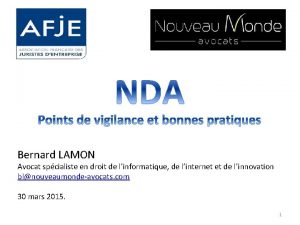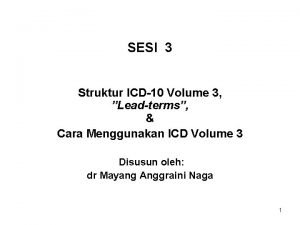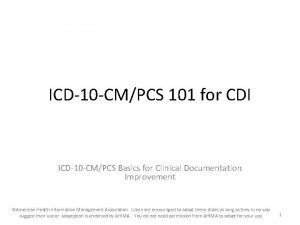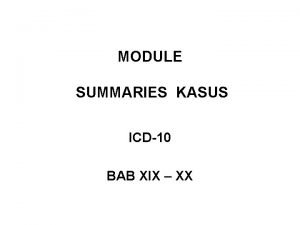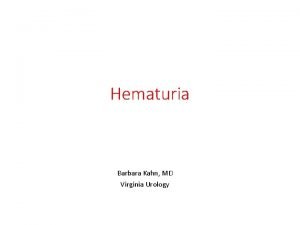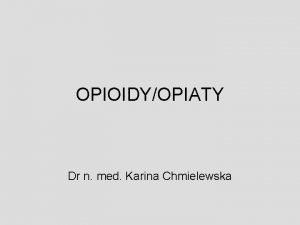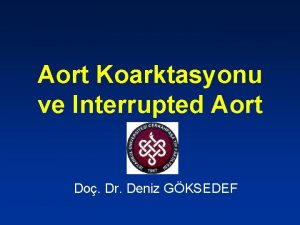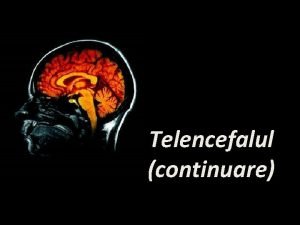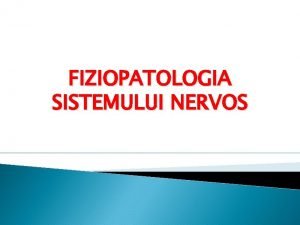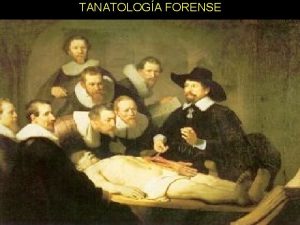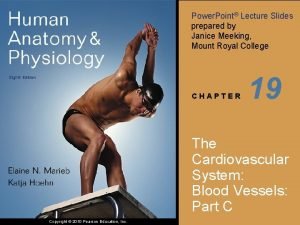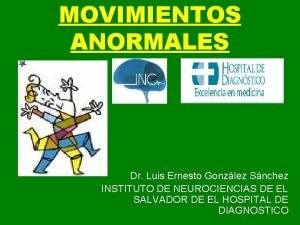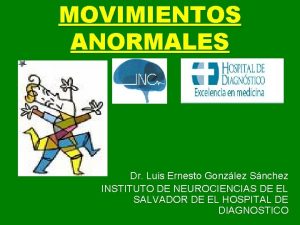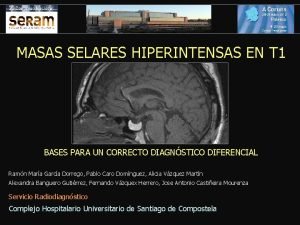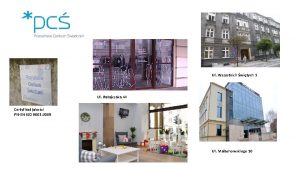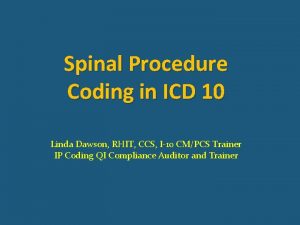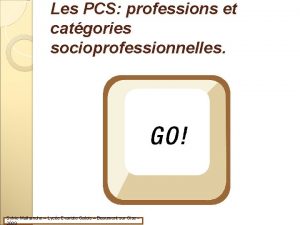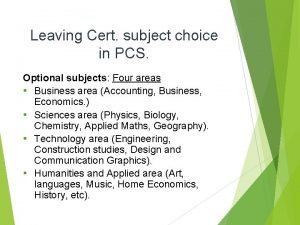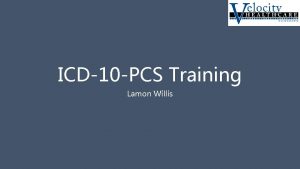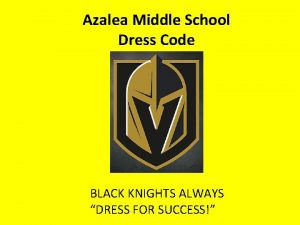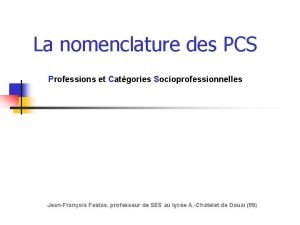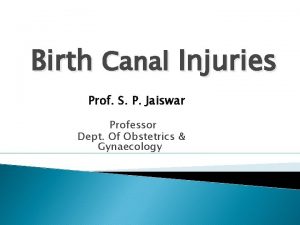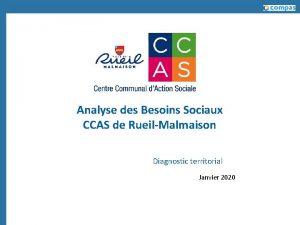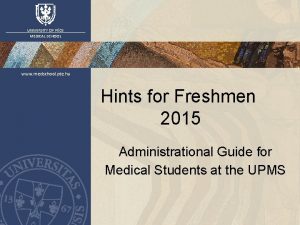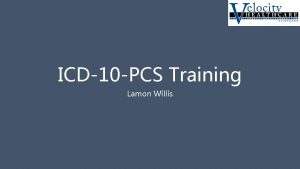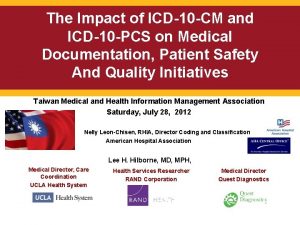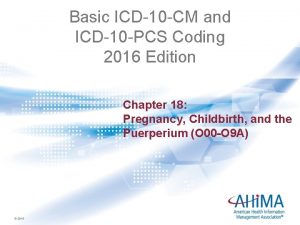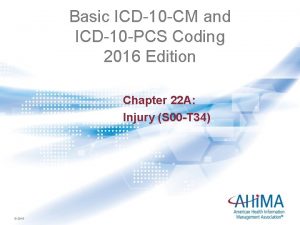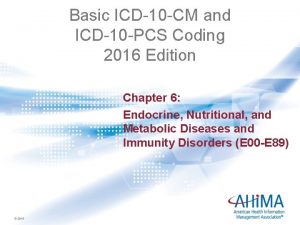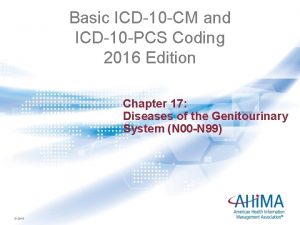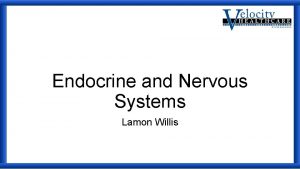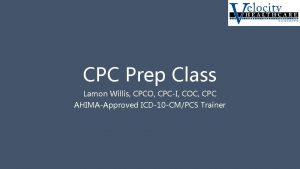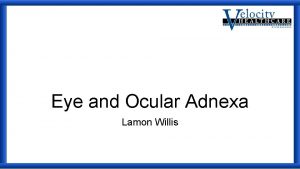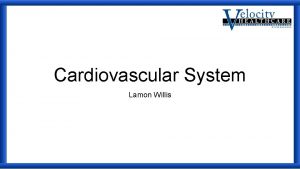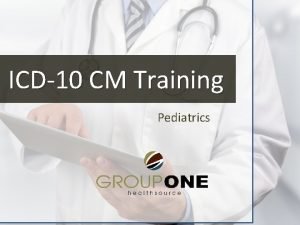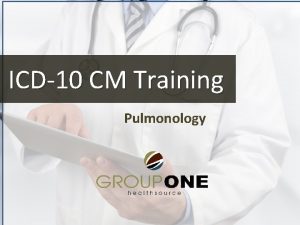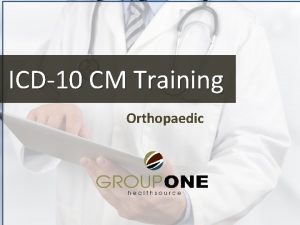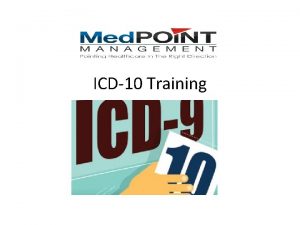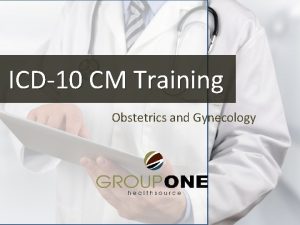ICD10 PCS Training Lamon Willis PCS Guidelines PCS























































- Slides: 55

ICD-10 -PCS Training Lamon Willis

PCS Guidelines

PCS Guidelines • Many of the terms used to construct PCS codes are defined within the system. It is the coder’s responsibility to determine what the documentation in the medical record equates to in the PCS definitions. The physician is not expected to use the terms used in PCS code descriptions, nor is the coder required to query the physician when the correlation between the documentation and the defined PCS terms is clear. • Example: When the physician documents “partial resection, ” the coder can independently correlate “partial resection” to the root operation Excision without querying the physician for clarification.

PCS Section of ICD-10

PCS Section of ICD-10 Index Tables • Main index term is a root operation, root procedure type, or common procedure name. Examples are: • When reviewing tables, sometimes there are multiple tables for the first three characters and they may cover multiple pages in the code book. • Resection • Fluoroscopy • Prostatectomy

Medical & Surgical Section Character 1 Character 2 Character 3 Character Section Body System Root Operation Body Part Approach 4 5 • All codes in PCS are seven characters • Letters O and I not used in PCS • Numbers 0 and 1 used • Each character has a meaning • Meanings change by sections • Section provides first character value • Sections of ICD-10 -PCS listed in manual Character 6 Character 7 Device Qualifier

Medical & Surgical Section Character 1 Character 2 Character 3 Character Section Body System Root Operation Body Part Approach 4 5 Character 6 Character 7 Device Qualifier • Second character • Body system, general physiological system, or anatomical region involved. What are the differences between Character 2 – Body System, and Character 4 – Body Part?

Medical & Surgical Section

Medical & Surgical Section • The body systems are unique to the Section the 31 systems above are only for the Medical and Surgical Section. • For example, in the Obstetrics section the only body system is 0 = Pregnancy. • In the Administration section there is a Body System of E = Physiological Systems and Anatomical Regions.

Medical & Surgical Section What systems?

Medical & Surgical Section Thorax – Body System or Body Part?

Medical & Surgical Section

Medical & Surgical Section B 2. 1 a Anatomical Regions B 2. 1 b Upper or Lower

Medical & Surgical Section • B 2. 1 a - The procedure codes in the general anatomical regions body systems can be used when the procedure is performed on an anatomical region rather than a specific body part (e. g. , root operations Control and Detachment, Drainage of a body cavity) or on the rare occasion when no information is available to support assignment of a code to a specific body part.

Medical & Surgical Section • Examples: • Control of postoperative hemorrhage is coded to the root operation Control found in the general anatomical regions body systems. • Chest tube drainage of the pleural cavity is coded to the root operation Drainage found in the general anatomical regions body systems. • Suture repair of the abdominal wall is coded to the root operation Repair in the general anatomical regions body system.

Medical & Surgical Section • B 2. 1 b - Where the general body part values “upper” and “lower” are provided as an option in the Upper Arteries, Lower Arteries, Upper Veins, Lower Veins, Muscles and Tendons body systems, “upper” or “lower “specifies body parts located above or below the diaphragm respectively.

Medical & Surgical Section • Example: • Vein body parts above the diaphragm are found in the Upper Veins body system; vein body parts below the diaphragm are found in the Lower Veins body system.

Medical & Surgical Section Character 1 Character 2 Character 3 Character Section Body System Root Operation Body Part Approach B 3. 1 a • Full definition B 3. 1 b • Integral to procedure B 3. 2 • Multiple procedures B 3. 3 • Discontinued procedures B 3. 4 a • Biopsy procedures B 3. 4 b • Biopsy followed by treatment B 3. 5 • Overlapping body layers 4 5 Character 6 Character 7 Device Qualifier

Medical & Surgical Section

Medical & Surgical Section • What root operation does this procedure belong to? • Excision • Detachment • Drainage • Division • Extirpation • Release

Medical & Surgical Section • What root operation does this procedure belong to? • Extirpation

Medical & Surgical Section • What root operation does this procedure belong to? • Transplantation • Transfer • Release • Excision • Extirpation • Reposition

Medical & Surgical Section • What root operation does this procedure belong to? • Transfer

Medical & Surgical Section Character 1 Character 2 Character 3 Character Section Body System Root Operation Body Part Approach • Fourth character • Anatomical site for procedure • 34 possible values per body system 4 5 Character 6 Character 7 Device Qualifier Examples of Body Parts: • Liver • Kidney • Thalamus • Ascending Colon • Optic Nerve • Tonsil

Medical & Surgical Section Marginal, right ventricle, posterior inter -ventricular, right coronary arteries

B 4. 1 a • Portion of body part B 4. 1 b • “Peri” B 4. 2 • Branches of body parts B 4. 3 • Bilateral body part values Medical & Surgical Section

Medical & Surgical Section B 4. 4 • Coronary Arteries B 4. 5 • Tendons, Ligaments, Bursae, Fascia Near a Joint B 4. 6 • Skin, Subcutaneous Tissue, Fascia Overlying Joint B 4. 7 • Fingers and Toes B 4. 8 • Upper and Lower Intestinal Tract

Medical & Surgical Section Coding Note: Central Nervous System (0) vs. Peripheral Nervous System (1) • It is important to review anatomy regarding nerves. • Examples of Central Nervous System: • brain, optic nerve, • trigeminal nerve, • vagus nerve, • spinal meninges

Medical & Surgical Section Coding Note: Central Nervous System (0) vs. Peripheral Nervous System (1) • It is important to review anatomy regarding nerves. • Examples of Peripheral Nervous System: • cervical nerve, • ulnar nerve, • radial nerve, • thoracic nerve, • tibial nerve, • sciatic nerve, • sacral plexus

Medical & Surgical Section Character 1 Character 2 Character 3 Character Section Body System Root Operation Body Part Approach 4 5 Character 6 Character 7 Device Qualifier • Fifth character – approach or technique used to reach procedure • Seven different approach values • Approach may be • Through skin or mucous membrane • Through orifice • External

Medical & Surgical Section Approaches Skin or Mucous Membranes • Open • Percutaneous Endoscopic Through an Orifice • Via Natural or Artificial Opening Endoscopic • Via Natural or Artificial Opening with Percutaneous Endoscopic Assistance NOTE: When assigning the approach value, remember that the approach defines the technique used to reach the procedure site, not necessarily the instruments used.

Medical & Surgical Section Approaches 0 • Open 3 • Percutaneous 4 • Percutaneous Endoscopic 7 • Via Natural/Artificial Opening 8 • Natural/Artificial Opening Endoscopic F • Natural/Artificial Opening with Percutaneous Endoscopic Assistance X • External

Medical & Surgical Section Endoscopic Assistance B 5. 2 External Approach B 5. 3 a B 5. 3 b Percutaneous Procedure via Device B 5. 4

Medical & Surgical Section Character 1 Character 2 Character 3 Character Section Body System Root Operation Body Part Approach 4 5 Sixth character Device must be left in place Review definitions of categories Character 6 Character 7 Device Qualifier

Medical & Surgical Section Four Basic Groups • Grafts and Prostheses • Implants • Simple or Mechanical Appliances • Electronic Appliances

Medical & Surgical Section • Examples of Device Values: Coding Note: Devices Only procedures that have a device that remains after the procedure is completed will have a specific device value assigned. Remember that all codes require seven characters. The default value to indicate that NO device was involved is Z. • Drainage device • Radioactive element • Autologous tissue substitute • Extraluminal device • Intraluminal device • Synthetic substitute • Nonautologous tissue substitute

Medical & Surgical Section • NEC in Medical/Surgical Section Root Operation Value Q Repair Device Value Y – Other Device Coding Note: Materials incidental to a procedure, such as clips and sutures, are not considered devices.

Medical & Surgical Section General • B 6. 1 a Device must remain • B 6. 1 b Integral to procedure • B 6. 1 c Procedures performed on device Drainage Device • B 6. 2 Separate procedure to put in drainage device

Medical & Surgical Section Character 1 Character 2 Character 3 Character Section Body System Root Operation Body Part Approach 4 5 Character 6 Character 7 Device Qualifier • Seventh character • Provides additional information • May have narrow application • There are no specific guidelines for qualifiers.

Medical & Surgical Section Examples of Qualifiers Type of transplant Second site for a bypass Diagnostic excision (biopsy)

Medical & Surgical Section Coding Note: Most procedures will not have an applicable qualifier. The default value to indicate that NO qualifier is needed is Z. Z

Test Your Knowledge • True or false? • A biological or synthetic material that takes the place of all or a portion of a body part such as a Joint Prosthesis would qualify as a device in ICD-10 -PCS.

Test Your Knowledge • True or false? • A biological or synthetic material that takes the place of all or a portion of a body part such as a Joint Prosthesis would qualify as a device in ICD-10 -PCS. Answer: True • Rationale: A device is specified in the sixth character and is used to identify devices that remain after the procedure is completed (Coding Guideline B 6. 1 a).

Test Your Knowledge • True or false? • According to ICD-10 -PCS Coding Guidelines, if a diagnostic biopsy is followed by a therapeutic definitive procedure at the same site, code only therapeutic excision or resection.

Test Your Knowledge • True or false? • According to ICD-10 -PCS Coding Guidelines, if a diagnostic biopsy is followed by a therapeutic definitive procedure at the same site, code only therapeutic excision or resection. • Answer: False • Rationale: Coding Guideline B 3. 4 b states if a diagnostic excision (biopsy) is followed by a more definitive procedure at the same procedure site, both the biopsy and more definitive treatment are coded.

Test Your Knowledge • True or false? • In the root operation Release, the body part character is defined as the body part being freed and not the tissue that is being cut to free the body part

Test Your Knowledge • True or false? • In the root operation Release, the body part character is defined as the body part being freed and not the tissue that is being cut to free the body part • Answer: True • Rationale: In the root operation Release, the body part value coded is the body part being freed and not the tissue being manipulated or cut to free the body part (Coding Guideline B 3. 13).

Test Your Knowledge • True or false? • Two codes would be assigned for this procedure: Resection of a joint with joint replacement.

Test Your Knowledge • True or false? • Two codes would be assigned for this procedure: Resection of a joint with joint replacement. • Answer: b. False • Rationale: Components of a procedure specified in the root operation definition and explanation are not coded separately (Coding guideline B 3. 1 b). • Example: Resection of a joint as part of a joint replacement procedure is included in the root operation definition of Replacement and is not coded separately.

Test Your Knowledge • True or false? • If the prefix peri is used with a body part to identify the site of the procedure, the procedure is coded to the body part named.

Test Your Knowledge • True or false? • If the prefix peri is used with a body part to identify the site of the procedure, the procedure is coded to the body part named. • Answer: True • Rationale: If the prefix peri is combined with a body part to identify the site of the procedure, the procedure is coded to the body part named (Coding Guideline B 4. 1 b). • Example: A procedure site identified as perirenal is coded to the kidney body part.

Test Your Knowledge • True or false? • Materials such as sutures, ligatures, radiological markers, and temporary postop wound drains should be coded separately using ICD-10 -PCS device codes.

Test Your Knowledge • True or false? • Materials such as sutures, ligatures, radiological markers, and temporary postop wound drains should be coded separately using ICD-10 -PCS device codes. • Answer: False • Rationale: Materials such as sutures, ligatures, radiological markers, and temporary postoperative wound drains are considered integral to the performance of a procedure and are not coded as devices (Coding Guideline B 6. 1 b).

Test Your Knowledge True or false? • Irrigation of a percutaneous nephrostomy tube is coded to the root operation Irrigation of indwelling device in the Administration section.

Test Your Knowledge True or false? • Irrigation of a percutaneous nephrostomy tube is coded to the root operation Irrigation of indwelling device in the Administration section. • Answer: True • Rationale: Procedures performed on a device only and not on a body part are specified in the root operations Change, Irrigation, Removal, and Revision, and are coded to the procedure performed (Coding Guideline B 6. 1 c). • Example: Irrigation of percutaneous nephrostomy tube is coded to the root operation Irrigation of indwelling device in the Administration section.
 Bernard lamon
Bernard lamon Luka tembak icd 10
Luka tembak icd 10 Icd 10 nihl
Icd 10 nihl Icd 10 fraktur klavikula
Icd 10 fraktur klavikula Icd 10 ablatio retinae
Icd 10 ablatio retinae Icd-10 for orthopaedics
Icd-10 for orthopaedics Cdi icd10
Cdi icd10 Icd 10 code for allergic conjunctivitis
Icd 10 code for allergic conjunctivitis Icd10 sungsang
Icd10 sungsang Isrr icd 10
Isrr icd 10 Icd10 urologists
Icd10 urologists Armd icd 10
Armd icd 10 Karina chmielewska
Karina chmielewska Neurologie
Neurologie Preduktal aort koarktasyonu
Preduktal aort koarktasyonu Bruce willis
Bruce willis Poligonul lui willis
Poligonul lui willis Wild ocean enterprise
Wild ocean enterprise Willis stifinder
Willis stifinder Dede willis
Dede willis Dr. bailey willis philippines
Dr. bailey willis philippines Dr angela willis
Dr angela willis Cascada coagularii schema
Cascada coagularii schema Robert john willis
Robert john willis Willis high school football
Willis high school football Imos landing page
Imos landing page Zdenka willis
Zdenka willis Signos cadavericos
Signos cadavericos Willis
Willis Willis lang
Willis lang Atp13a2
Atp13a2 Venus de milo
Venus de milo Poligono de willis
Poligono de willis Marxist ideology
Marxist ideology Blood vessel types
Blood vessel types Geoff willis
Geoff willis Teoria de la resistencia paul willis
Teoria de la resistencia paul willis Willis definition of neoplasia
Willis definition of neoplasia Miranda willis
Miranda willis Earoles
Earoles Training guidelines and principles of badminton
Training guidelines and principles of badminton Poznańskie centrum świadczeń
Poznańskie centrum świadczeń Tofd pcs calculator
Tofd pcs calculator Vertebroplasty icd 10 code
Vertebroplasty icd 10 code Pcs advanced scholar
Pcs advanced scholar Critères de construction des pcs
Critères de construction des pcs Pcs compulsory subjects
Pcs compulsory subjects Posterior capsulotomy knee pcs code
Posterior capsulotomy knee pcs code Gis cloud computing
Gis cloud computing Azalea middle school dress code 2021
Azalea middle school dress code 2021 Pcs
Pcs App.gis-div/pcs web
App.gis-div/pcs web Periclitoral laceration repair icd 10 pcs
Periclitoral laceration repair icd 10 pcs Evolution des pcs
Evolution des pcs Pcs medizin
Pcs medizin Pcs back office
Pcs back office
